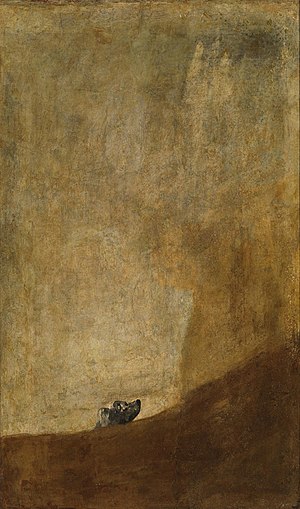Dog (goya)

|
| dog |
|---|
| Francisco de Goya , 1820/1823 |
| Transferring oil on plaster onto canvas |
| 134 × 80 cm |
| Museo del Prado, Madrid |
Dog (Spanish: El perro or Perro semihundido ) is the title of a painting by Francisco de Goya , created between 1820 and 1823. It belongs to the ensemble of the so-called Pinturas negras and is located in the Museo del Prado in Madrid .
dog
The painting shows a dog's head in profile, the rest of the animal is covered by a diagonal surface. The dog looks up into the picture on the right, where nothing can be seen. The dog and the surface covering it, laid out in earthy, gray tones, form the lower fifth of the picture; the entire upper part of the painting is done in tones of ocher and brown, with blends of blue and green, and forms an empty surface.
The narrow vertical format with the dog's head is part of an ensemble of two times seven works by Goya that have been listed in art history as Pinturas negras , the black paintings . The painter worked them between 1820 and 1823 on the plaster on the two floors of his country house Quinta del Sordo (country house of the pigeon) near Madrid. The dog hung on the upper floor, flanked by two large works showing groups of figures hovering over landscapes. The black paintings are seen as “painted space explorations” in which the dog in the “flash flood-like emptiness” with a “shy look” represents a promise: “His thirst for sight is that of the painter.”
Provenance
In February 1819 Goya had acquired the country house and furnished the two rooms on the first and second floors with seven paintings on the plaster. From 1824 Goya lived in Bordeaux until his death in 1828 , the paintings remained in the country house. In 1860 they were removed and, after their restoration, put on canvases individually. In 1878 they were shown at the World Exhibition in Paris , but were not noticed there. In 1881 the owner, Baron Émile d'Erlanger, gave it to the Spanish state; they were decreed in the Prado. After its decline, the Quinta del Sordo was finally demolished in 1909.
reception
The Spanish artist Antonio Saura was a great admirer of Goya and received the dog portrait several times from 1967 onwards. Saura described the painting as "the most beautiful picture in the world." Another of Goya's compatriots, the painter Rafael Canogar , called the picture a "visual poem" and classified it as "the first symbolist work of the West."
In 2003 the New York Times Magazine published the thesis of the Spanish art historian Juan José Junquera that the Pinturas negras , including the dog , are fakes. The art scholar derived the claim that the paintings were made after Goya's death from researching the sources of the history of the country house and the history of the restoration of the pictures.
literature
- Werner Hofmann : Goya. From heaven through the world to hell . CH Beck, Munich 2003, ISBN 3-406-48619-3 , pp. 231-246.
Individual evidence
- ↑ Werner Hofmann: Goya (2003), p. 238
- ↑ Werner Hofmann: Goya (2003), p. 231
- ↑ Rafael Fraguas: Visita a la Quinta del Sordo , elpais.com, accessed on April 15, 2018
- ↑ For pictures see website Antonio Saura : Link paintings → goya
- ↑ Susana Calvo Capilla: Un perro semihundido. November 23, 1999, accessed December 4, 2009 (Spanish).
- ^ Arthur Lubow: The Secret of the Black Paintings . In: New York Times Magazine , July 27, 2003 ; Retrieved November 25, 2009
Web links
- Image description at artinspector
- The dog in the Prado's online gallery: Spanish / English
- Virtual reconstruction of the Quinta del Sordo with the Pinturas negras (Spanish)
